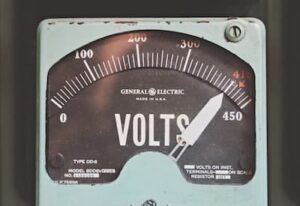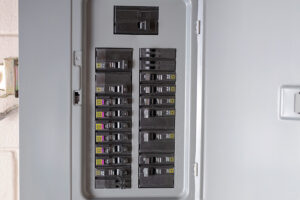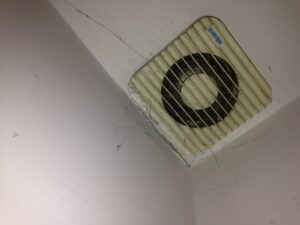Chances are you have surge protectors in your home, especially if you require multiple electrical devices to be plugged into a single electrical outlet. Maybe the protectors are cluttering the living room floor or stuck behind a desk or a couch. Perhaps you have surge protector receptacles elegantly installed in the wall. Nifty! We all understand the need to protect our appliances and electronics from surges, but how much do we really understand about power surges themselves?
Spikes in your home’s electrical current happen with surprising frequency. Most surges last for a fraction of a second and are harmless — to our service panel, our devices, and ourselves. Yet, while spikes don’t often last long, they can be powerful enough to cause damage to electronic devices and electrical wiring — and even lead to electrical fires.
What Are Power Surges?
A high power surge can happen when electricity is interrupted then immediately re-established. This occurrence forces too much current through the electrical system. Surges have the ability to knock out your delicate electronics, cause fires, and wreak havoc up and down the circuitry of your home or business.
Internal Surges
Internal power surges are the most common type. More than 50 percent of household surges are of this variety. They may occur dozens of times every day. Most surges are too small to be detected by the human senses and not strong enough to interrupt electrical service. They pass through your home’s wires, and no one’s ever the wiser. Fortunately, modern electronics can resist these minuscule spikes and keep electricity flowing.
Refrigerators, air conditioners, and other appliances can cause surges when they’re switched on. This type of problem happens most often when your home has faulty wiring. Tripped circuit breakers and short circuits can also create spikes in current. This kind of internal surge is powerful enough to cause damage.
If you suspect your home has bad wiring, contact your utility company immediately.
External Surges
External power surges are usually greater than the internal variety. They may happen when trees, tree branches, or anything else, really, fall onto a power line. Lightning strikes are another cause. A single strike near a power line could fry a television or computer monitor.
How to Prevent Power Surges
The National Electrical Manufacturers Association (NEMA) estimates that 60% to 80% of surges are created when large appliances, such as air conditioners, cycle off and on. Appliances such as dryers will cause big power draws when connected to individual circuits. They can also cause major power stoppages when powered on and off. Electronics connected to the same circuit will deal with the same impact across the board.
Appliances such as dryers will cause big power draws when connected to individual circuits. They can also cause major power stoppages when powered on and off. Electronics connected to the same circuit will deal with the same impact across the board.
This is why it is so critical to take advantage of individual power surge protector (or “bricks”) as much as possible. This is especially important when connecting expensive and delicate electronics to the outlet. You don’t want to fry your expensive new laptop or big screen TV because you started the washing machine at the same time.
Get A Home Surge Arrester
 The first thing you should do to protect your home from a power surge is to invest in a whole home arrester as soon as possible. It’s basically a house surge protector. They’re a bit more expensive than plugging surge protectors into all of your outlets and hoping for the best. Still, a whole home search device will protect your circuits directly at the electrical panel. It will modulate and control your home’s power and make sure it flows steadily, efficiently, and continuously.
The first thing you should do to protect your home from a power surge is to invest in a whole home arrester as soon as possible. It’s basically a house surge protector. They’re a bit more expensive than plugging surge protectors into all of your outlets and hoping for the best. Still, a whole home search device will protect your circuits directly at the electrical panel. It will modulate and control your home’s power and make sure it flows steadily, efficiently, and continuously.
This is the kind of upgrade you want to make with the help of the best electrician in the area. They will have to do all the heavy lifting to install this kind of setup. Once installed, however, you will never have to worry about surges again.
Call the award-winning electrical experts at Prairie Electric today to learn more about how you can protect your home or business!


